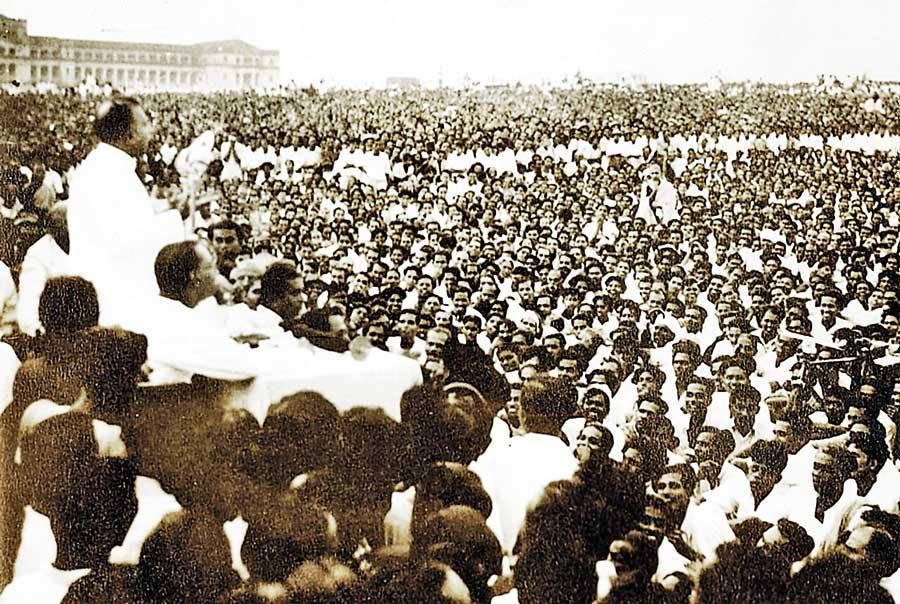Reply To:
Name - Reply Comment

Hartal organised in 1953
The tremendous power of the masses in action was displayed for the first time in post-independent Sri Lanka on August 12, 1953 when the enraged people rose in active dissent. A new factor re-entered our politics; the wisdom of mass power directed a mass intervention.
factor re-entered our politics; the wisdom of mass power directed a mass intervention.
The vast expansion of people was observed in towns and villages, symbolising an active vote of no-confidence of the then UNP government, somewhat similar to May 6, ‘22. Despite its insurrectionary nature, the August 12 Hartal [civil disobedience and strike] was a democratic movement which spread along the western and south-western coastal territories and reached other parts in the island.
Returning to Ceylon from UK-US Universities, NM, Colvin, Philip, Leslie and Pieter and a few other young radicals impregnated by Marxist ideology, founded the LSSP on December 18, 1935, which later progressed in the direction of Trotskyism. The strike was, of course, conventional then; but the hartal idea was new. It was a mass weapon capable of radical progress, which our young Marxists experienced in India, after scooting off to Madras following their historic WW II prison escape in August 1942. The final call for the August 12 hartal and strike went out in the names of the three left parties the Ceylon Trade Union Federation, the Ceylon Federation of Labour, the Ceylon Labour Union, the Harbour and Dock Workers’ Union and the Ceylon Mercantile Union.The Federal Party issued a call separately in support of the strike and hartal.
The LSSP covered the country over the weeks with several meetings. Thus, the rural masses commenced joining the struggle with the city workers. Through this reciprocal action, the worker-peasant alliance was achieved.
The hartal ‘53 involved lakhs of people also enjoyed the sympathy of millions. So powerful was the movement, every race every religion was in it, including the Catholics – in the Negombo, Wennappuwa and Ragama areas. This mass movement achieved the level of a mass uprising. The people did not merely protest against the Government; they were on streets to express their opposition to the Government, carrying through the expression of their hostility in rebelliousness of defying authority and the law. They stopped buses, trains, and all forms of transport; caused factories, shops and offices to close.
It was not only ‘peaceful persuasion, but on the railway lines, rails and fishplates were removed and sleepers dislodged, had torn up and turned over for miles, and the telephone posts also had been toppled. In hundreds of places, the signal wires had been cut. In coastal areas, they captured trains and uncoupled the engines. The hatred of the people, always directed against the bus companies monopolists the political pillars of the Government : the buses of Gamini Bus Co Ltd and the High Level Road Bus Co Ltd were stopped, stoned, and smashed. Their routes were blocked and cluttered with felled trees, making even a military escort could not get to their destinations. Many small bridges were dynamited. The postal and other public services were totally paralysed.
The hartal was a pre-planned Marxist-initiated mass struggle which ended with the tragic death of nine protesters. The then entire cabinet, along with top bureaucrats sought refuge in a British warship, “HMS Newfoundland” that was anchored in Colombo harbour. Prime Minister Dudley Senanayake was not “replaced” by another as a consequence. The 42-year-old Dudley’s exit three months later in October, was due to health issues [a long story] and Kotelawala, the rightful claimant even at the time of D.S. Senanayake’s death in 1952, took over. UNP’s defeat three years later had different attributes.
11th May Indefinite Hartal?
A columnist suggested last week of a “double-barrelled plan” when he pronounced, “firstly, a General Strike centric Hartal on May 6. If it fails to convince Gotabaya Rajapaksa to vacate the Presidency, the struggle escalates to the next level of an open-ended General Strike and Hartal starting May 11.”
As he speculated, the double-barrelled plan; the General Strike centric Hartal on May 6 has convinced Gotabaya to request brother Mahinda to vacate. Hartalists warned that if the president and his cabinet ignore their voice, they would continue the hartal from May 11 till a breakthrough is achieved. So the struggle will escalate to the second level— ‘a perpetual General Strike centric Hartal starting May 11.’
The History of the Rice-Subsidy:
Within a month, the anticipated deficit rose manifold; the rice ration accounted for 72 per cent of the budget deficit. Pruning the subsidy became inevitable! Concluding his budget speech on July 23, 1953, JRJ said…, “…solution lay in elimination of overall deficit…, but it was not possible to take this step without removing as well, the subsidy on food”. – July 23, 1953: Col. 807-Hansard. The socially insensitive government of Senanayake-Jayewardene, blundered by attempting to cut it in one stroke. This resulted in a substantial rise in the price of rice from -/25 to -/70 cents a measure. The masses rose in response to the leftist’s call for a Hartal.
The government imposed Martial Law and a twenty-four-hour curfew under emergency regulations. The armed forces were authorised the use of firepower to suppress violence and rioting.
The Hartal had little impact on UNP’s 1956 defeat at the hands of Bandaranaike’s SLFP. The ultra-racist “Sinhala only in 24 Hrs” had the ‘poor’ village folk trapped; much like the Sinhala/Buddhist oriented campaign that led to Gotabaya Rajapaksa’s victory in 2019. Kotelawala’s flamboyant attitude and the company he kept, were added disqualifications. Bandaranaike, ‘The Expedient Utopian’, as James Manor described him, used his ‘Double-edged’ weapon for destroying the Marxist LSSP and CP of their well deserved legitimate share in 1956. They who led a successful campaign triggered by ‘Hartal ’53’, winning the rights of masses, were beaten by the introduction of racism to brainwash ‘Sangha, Veda, Guru,…etc.,’ The Marxist’s natural antipathy to chauvinism cost them votes in favour of Bandaranaike’s Sinhala/Buddhist extremism; in spite of leftists being hailed by the downtrodden masses as Heroes of Hartal ‘53.
1956 - General Elections—
Victories in the Local Government polls in Matara and two by-elections gave them confidence. This prompted Prime Minister Sir John to dissolve Parliament a year ahead of the scheduled date, early in February 1956. Bandaranaike’s new party, the SLFP, championing a popular socialist stage, promised to make Sinhala the official language. The UNP, who hitherto, defended the rights of minorities, made the biggest blunder by changing its posture in early 1956, to fall in line with Bandaranaike, who responded with a new slogan; “Sinhala only in 24 hours.” Under Sir John’s premiership, 1952--1956, the gap between the UNP and the ordinary people, widened. He was unsuccessful in evaluating the emergence of the economic, language and cultural revitalisation. The UNP government of John Kotelawala, in 1956, had been fast losing strength. Poor economic performances, disregard for the masses’ aspirations and Kotelawala’s elitist style of governance, had all contributed towards his and UNP’s downfall.
Can they ignore the admonition issued by TUs that they will commence a continuous hartal from May 11 unless both the government as well as President step down without delay. However, the protesters have a better option in extending the ‘GoGotagama’ to every town and village. The current stalemate has taken a heavy toll on the nation. The people have discarded all 225+1 –both in the government and the Opposition; they should recognise the danger of aggravating the public animosity further.